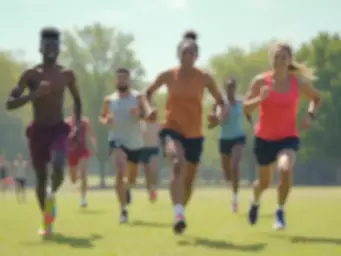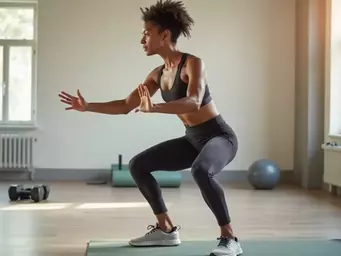Movement Science in Exercise Physiology
By Dr. Lena Schippert / Nov 10
Understanding the mechanics of your body can significantly impact your fitness journey. By delving into biomechanics, you open the door to safer, more effective movement patterns that promote health and performance. Are you ready to take your fitness to the next level?
This visual outlines the core biomechanical principles discussed and their practical application in fitness and movement science.
Focuses on the mechanics of human movement, examining how muscles, joints, and bones work together. Optimizes forces for movement efficiency.
Understanding these helps optimize movement patterns and minimize injury risk during exercise and daily activities.
These two aspects help analyze and improve movement by evaluating motion and the forces causing it.
Understanding their interaction is crucial for informed fitness choices and optimal function.
Vital for tailoring fitness programs to individual needs, identifying areas for improvement, and monitoring progress.
The brain's ability to coordinate muscles and movements, essential for functional fitness and injury reduction.
Welcome to the fascinating world of biomechanics! As an exercise physiologist, I’ve always found that understanding how our bodies move is not just intriguing—it’s essential for anyone looking to enhance their fitness and health. By diving into the principles of biomechanics, we can unlock the secrets to improved performance, injury prevention, and overall well-being.
So, why does biomechanics matter? It’s the science that examines the structure and function of biological systems through mechanical principles. When we grasp these concepts, it can profoundly affect how we approach exercise and daily activities. Let’s explore this further!
In simple terms, biomechanics focuses on the mechanics of human movement, which means it examines how our muscles, joints, and bones work together during physical activities. It’s all about understanding the forces acting on our body and how we can optimize these forces to improve movement efficiency.
For example, when I work with clients at Functional Fitness & Movement Science, I emphasize the importance of understanding their body mechanics. This knowledge can greatly influence not only their fitness performance but also their everyday movements!
There’s a strong link between biomechanics and health. Proper movement patterns can significantly reduce the risk of injuries and enhance our physical capabilities. Think about it: when you understand how to move correctly, you can avoid unnecessary strains and sprains, leading to a more active and fulfilling life.
Here are a few key reasons why understanding biomechanics is important:
Let’s dig deeper into the core principles of biomechanics. Understanding force and leverage can help you optimize your movement patterns during exercise. For instance, knowing how to leverage your body weight can make tasks like squatting or lifting more effective and safer.
Incorporating these principles into your workout routine can enhance your performance while minimizing the risk of injury. Isn’t it fascinating how a little knowledge can open up a world of possibilities?
Kinematics and kinetics are two critical aspects of biomechanics. Kinematics deals with the motion of bodies without considering the forces involved, while kinetics looks at the forces that cause these motions. Understanding both can help us analyze our movements and identify areas for improvement.
In practical terms, this means evaluating how you run, jump, or perform a squat can reveal patterns that may need correction. By addressing these issues, we can refine your technique and boost your effectiveness!
Your muscles and joints work together like a well-oiled machine. When you understand how they interact, you can make more informed choices about your fitness regime. For example, maintaining proper joint alignment during exercises allows your muscles to function optimally.
So, how does this play out in real life? Here are some critical points to consider:
To truly harness the power of biomechanics in your fitness journey, consider incorporating video analysis into your training. By recording your movements, you can visually identify areas that need adjustment, ensuring proper form and technique. This not only enhances your effectiveness but also helps in preventing injuries. Don't hesitate to seek guidance from a professional who can help interpret the footage and provide tailored feedback!
As we delve deeper into the world of functional fitness, understanding biomechanics becomes a game changer in our approach to movement. It’s not just a collection of scientific principles; it’s about how we can apply these insights to enhance our daily lives and fitness routines. Here’s a quick recap of why biomechanics matters:
Biomechanics is the science that examines the structure and function of biological systems through mechanical principles. In fitness, it focuses on how muscles, joints, and bones work together during physical activities and how forces acting on the body can be optimized for movement efficiency, injury prevention, and performance enhancement.
Understanding biomechanics is crucial for fitness because it helps in injury prevention, enhances athletic performance by improving movement mechanics, and promotes long-term health by fostering a sustainable fitness routine. It allows individuals to move more efficiently and safely.
Kinematics deals with the motion of bodies without considering the forces involved (e.g., speed, acceleration, displacement). Kinetics, on the other hand, focuses on the forces that cause these motions (e.g., gravity, muscle forces, ground reaction forces). Both are essential for analyzing and improving movement technique.
Personalized assessments provide a clear picture of your unique movement capabilities and limitations. This allows fitness programs to be tailored to your individual needs, helping to identify areas for improvement, customize exercises, and effectively monitor progress, leading to better results and a more enjoyable fitness journey.
Neuromuscular control refers to the brain’s ability to communicate with muscles and coordinate movements. Improving neuromuscular control enhances stability and balance, reduces the risk of injury during physical activities, and boosts overall performance in sports and daily tasks. It is fundamental for functional fitness.
To effectively improve our movement efficiency, we need to focus on the key principles of biomechanics that influence our physical activities. These principles include:
Incorporating these principles into your fitness routine can lead to improved performance and reduced injury risk. Moreover, personalized assessments play a crucial role in tailoring fitness programs to your unique needs.
Understanding biomechanics is about appreciating the intricate relationship between our movements and our health. Some critical principles include:
These principles serve as the bedrock of a well-rounded fitness program, particularly when we aim for lifelong functionality!
At Functional Fitness & Movement Science, we emphasize the importance of personalized assessments. They provide a clear picture of your current movement capabilities and limitations. This process allows us to:
Implementing personalized assessments leads to better results and a more enjoyable fitness journey. Remember, every individual's body is unique—so shouldn’t your fitness plan be, too?
Neuromuscular control plays a pivotal role in how we move. It refers to the brain’s ability to communicate with muscles, coordinating movements. By improving neuromuscular control, we can:
Integrating exercises that focus on improving neuromuscular control will not only enhance your functional fitness but also contribute to better quality of life!
As we wrap up our exploration of biomechanics and functional fitness, I encourage you to take these steps toward better movement:
By taking these actionable steps, you’ll not only enhance your fitness journey but also contribute to your overall health and well-being.
Incorporating biomechanics into your fitness journey can seem daunting, but it’s easier than you think! Here’s how:
These steps will help you align your fitness goals with a deeper understanding of how your body works, paving the way for long-term success!
To continue your education in biomechanics and functional fitness, here are some valuable resources:
Investing time in these resources will deepen your understanding and empower you to make informed choices about your fitness journey.
Here is a quick recap of the important points discussed in the article:



 Movement Science in Exercise Physiology
In the world of fitness, understanding the intricate relationship between how we move and the scienc
Movement Science in Exercise Physiology
In the world of fitness, understanding the intricate relationship between how we move and the scienc
 Fixing Poor Form for Safety
Have you ever felt sore in unexpected places after a workout? This often points to poor form during
Fixing Poor Form for Safety
Have you ever felt sore in unexpected places after a workout? This often points to poor form during
 Injury Prevention Strategies for Lifelong Activity
What if the secret to a longer, healthier life lies in understanding how we move? By focusing on inj
Injury Prevention Strategies for Lifelong Activity
What if the secret to a longer, healthier life lies in understanding how we move? By focusing on inj